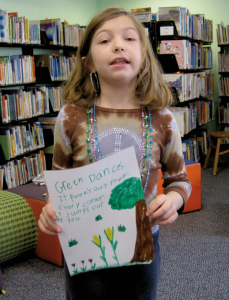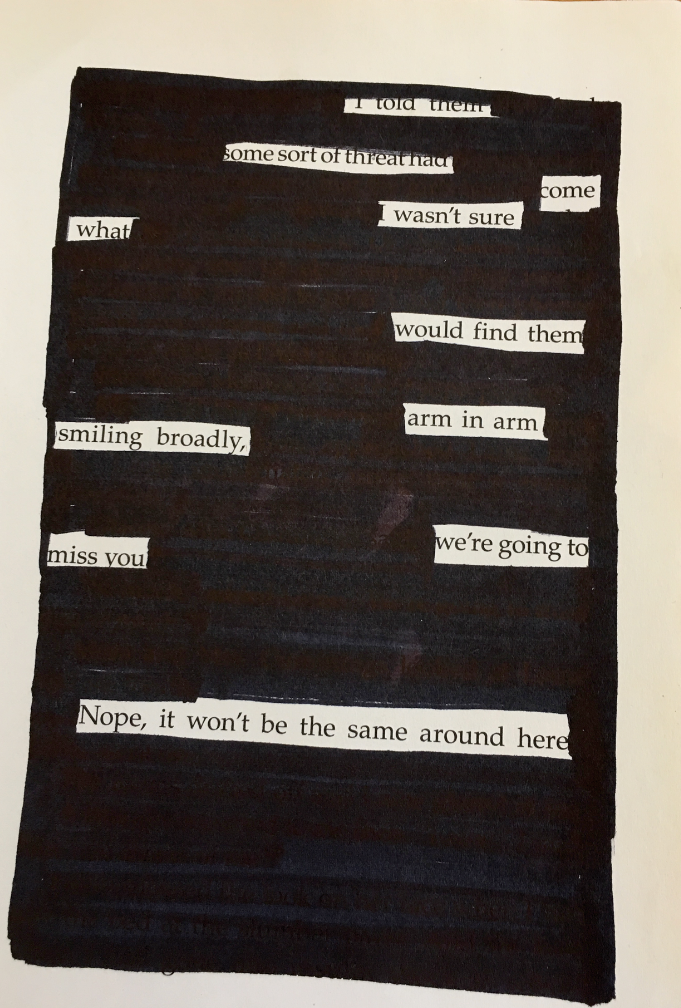11 Poetry


Full disclosure: I was someone who gave up Poetry (with a capital P) after the exhausting interpretive gymnastics of English 101. I was allergic to dudes in triboli hats declaiming their imitations of “Howl” from the postage-stamp-sized stages in the back of Brooklyn coffee shops. But when I became a children’s librarian, I became a poetry lover. I discovered Jack Prelutsky, Shel Silverstein, Kristine O’Connell George, Doug Florian, Jane Yolen, Pat Mora, Janet Wong, Nikki Grimes, Nikki Giovanni, Marilyn Singer, Marilyn Nelson, Judy Sierra, Naomi Shihab Nye, and Joyce Sidman. The rich collections selected by X. J. Kennedy and Lee Bennett Hopkins provided me with icebreakers for visits with classes of all ages. If the word “poetry” sets your teeth on edge, I have some words of hope for you: Poetry can be fun, poetry can be silly, and often at the same time—poetry can express emotions and states of feeling with a unique power.
-Ashley Bryan
In particular, poetry for children often exemplifies a special union of laughter and profundity. The esteemed poet, anthologist, and teacher Lee Bennett Hopkins wrote, “The first thing I think of when planning a collection is the child—what I want the child to reap. When it comes to poetry—pure poetry—I want children to see beauty in the world, feel emotion, compassion, to breathe deeply, utter, ‘Yes, this is how it is.'”[2]
Those revelations can come surprisingly early. I’ve found it’s possible to jolly a two-year-old out of an incipient breakdown by dramatically reciting these lines from Andrew Fusek:
I’m the no-no bird,
That’s right, that’s me.
I live up in
The Tantrum Tree.
I’m the no-no bird,
I won’t say why
I stamp my feet
And shout and cry.
This can be found in Here’s a Little Poem: A Very First Book of Poetry, a collection co-edited by Fusek and the esteemed poet Jane Yolen. The genius of these selections is that they reflect the developmental interests of young children. Wordplay, humor, and tongue-twisting verse about big feelings, baby brothers, and ice cream are all part of the landscape, brought to life with strong imaginative illustrations by Polly Dunbar.
Poetry is also an intergenerational delight, perfect for sharing with grandparents and great-grandparents, neighbors, and friends. Characters familiar to young and old make an early appearance in A. A. Milne’s 1924 collection, When We Were Very Young. “Disobedience,” for example, begins rhythmically:
James James
Morrison Morrison
Weatherby George Dupree
Took great
Care of his Mother,
Though he was only three.
James James
Said to his Mother,
‘Mother,’ he said, said he:
‘You must never go down to the end of town,
if you don’t go down with me.’
National Poem in Your Pocket Day
National Poem in Your Pocket Day is observed each April. This day was created to share the joy that poems bring by carrying one in your pocket and sharing it throughout the day with others.
Across the country, businesses, libraries, schools and individuals have shared a poem on National Poem in Your Pocket Day. A short poem might appear on your lunch receipt, or perhaps the mailperson will recite one in exchange for the outgoing mail.
HOW TO OBSERVE
Memorize a poem or two to share with the people you meet throughout the day. National Poem In Your Pocket Day is the perfect day to share your poem on Social Media using #PoemInYouPocketDay or #PocketPoem.
HISTORY
National Poem In Your Pocket Day has been celebrated as part of National Poetry Month since 2002. The Office of the New York Mayor, along with the New York City Departments of Cultural Affairs and Education, initiated the annual city-wide Poem In Your Pocket Day. The Academy of American Poets took Poem In Your Pocket Day national in 2008.
Mentor texts
Clinton, Catherine, and Stephen Alcorn. 1998. I, Too, Sing America: Three Centuries of African-American Poetry. Boston: Houghton Mifflin.
Florian, Douglas. 2000. Mammalabilia: Poems and Paintings. San Diego, Calif.: Harcourt.
Frame, Jeron Ashford, and R. Gregory Christie. 2003. Yesterday I Had the Blues. Berkley, CA: Tricycle Press.
George, Kristine O’Connell, and June Otani. 1999. Little Dog Poems. New York: Clarion Books.
Gollub, Matthew, and Kazuko G. Stone. 1998. Cool Melons–Turn to Frogs! The Life and Poems of Issa. New York: Lee & Low Books.
Grimes, Nikki, and Javaka Steptoe. 2001. A Pocketful of Poems. New York: Clarion Books.
Heard, Georgia. 2019. Boom! Bellow! Bleat! Animal Poems for Two or More Voices. Honesdale, PA: WordSong.
Hopkins, Lee Bennett, and Chris K. Soentpiet. 2010. Amazing Faces. New York: Lee & Low Books.
Janeczko, Paul B., and Christopher Raschka. 2001. A Poke in the I. Cambridge, MA: Candlewick Press.
Janeczko, Paul B., and Christopher Raschka. 2005. A Kick in the Head. Cambridge, MA: Candlewick Press.
Janeczko, Paul B., and Melissa Sweet. 2014. Firefly July: A Year of Very Short Poems. Somerville, MA: Candlewick Press.
Kennedy, X. J., Dorothy M. Kennedy, and Jane Dyer. 1992. Talking Like the Rain: A Read-to Me Book of Poems. Boston: Little, Brown.
Lewis, J. Patrick, and Lisa Desimini. 1998. Doodle Dandies: Poems That Take Shape. New York: Atheneum Books for Young Readers.
Livingston, Myra Cohn. 1992. I Never Told and Other Poems. New York: M.K. McElderry Books.
Medina, Jane, and Fabricio Vanden Broeck. 1999. My Name Is Jorge on Both Sides of the River: Poems. Honesdale, PA: Wordsong/Boyds Mills Press.
Nye, Naomi Shihab. 2018. Voices in the Air: Poems for Listeners. New York, NY: Greenwillow Books.
Nye, Naomi Shihab, and Ashley Bryan. 2000. Salting the Ocean: 100 Poems by Young Poets. New York: Greenwillow Books.
Rosenberg, Liz. 1996. The Invisible Ladder: An Anthology of Contemporary American Poems for Young Readers. New York: Henry Holt &; Co.
Sidman, Joyce, and Pamela Zagarenski. 2007. This Is Just to Say: Poems of Apology and Forgiveness. Boston: Houghton Mifflin Co.
Sidman, Joyce, and Pamela Zagarenski. 2009. Red Sings from Treetops: A Year in Colors. Boston: Houghton Mifflin Books for Children.
Sidman, Joyce, and Pamela Zagarenski. 2013. What the Heart Knows: Chants, Charms & Blessings. Boston: Houghton Mifflin Harcourt.
Singer, Marilyn, and Susan L. Roth. 2017. Every Month Is a New Year: Celebrations around the World. New York: Lee & Low Books Inc.
Yolen, Jane, Andrew Peters, and Polly Dunbar. 2007. Here’s a Little Poem: A Very First Book of Poetry. Cambridge, Mass.:
Poet websites
Jorge Argueta: www.jorgeargueta.com
Rebecca Kai Dotlich: www.rebeccakaidotlich.com
Douglas Florian: http://floriancafe.blogspot.com
Kristine O’Connell George: www.kristinegeorge.com
Nikki Grimes: www.nikkigrimes.com
Lee Bennett Hopkins: www.leebennetthopkins.com
J. Patrick Lewis: www.jpatricklewis.com
Deborah Ruddell: www.deborahruddell.com
Joyce Sidman: www.joycesidman.com
Janet Wong, Poetry Suitcase: www.janetwong.com/poetry-suitcase
Resources
Heard, Georgia. 1999. Awakening the Heart: Exploring Poetry in Elementary and Middle School. Portsmouth, NH: Heinemann.
Heard, Georgia. 2016. Heartmaps: Helping Students Create and Craft Authentic Writing. Portsmouth, NH: Heinemann.
Janeczko, Paul B. 2003. Opening a Door: Reading Poetry in the Middle School Classroom, Theory and Practice. New York: Scholastic Professional Books.
Koch, Kenneth. 1973. Rose, Where Did You Get That Red? Teaching Great Poetry to Children. New York: Random House.
Koch, Kenneth, and P.S. 61 in New York City. 1970. Wishes, Lies and Dreams; Teaching Children to Write Poetry. New York: Chelsea House Publishers.
Livingston, Myra Cohn. 1991. Poem-Making: Ways to Begin Writing Poetry. New York, NY: HarperCollins Publishers.
Livingston, Myra Cohn. 1997. I Am Writing a Poem About—a Game of Poetry: Edited by Myra Cohn Livingston. New York: McElderry Books.
McKee, Lori L, and Rachel M Heydon. 2015. “Orchestrating Literacies: Print Literacy Learning Opportunities within Multimodal Intergenerational Ensembles.” Journal of Early Childhood Literacy 15 (2):227-255.
McNair, Jonda C. 2012. “Poems About Sandwich Cookies, Jelly, and Chocolate: Poetry in K-3 Classrooms.” YC Young Children 67 (4):94.
Vardell, Sylvia M., and Janet Wong. 2018. Great Morning! Poems for School Leaders to Read. Princeton, NJ: Pomelo Books.
Weger Bowman, Elayne. 2015. “Embracing Common Core State Standards One Project at a Time.” The Clearing House: A Journal of Educational Strategies, Issues and Ideas 88 (3):91-95.
Wood, Jaime R. 2006. Living Voices: Multicultural Poetry in the Middle School Classroom. Urbana, IL.: National Council of Teachers of English.
Resource websites
National Education Association, Bringing Poetry to the Classroom, Grades K–5: z.umn.edu/wbr57.
Poem in Your Pocket Day: z.umn.edu/wbr58.

